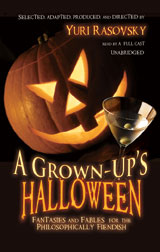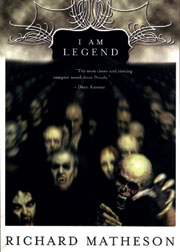Another
Column at MyShelf.Com
|
|||||||||||||||||
| Audio Buzz, Past |
|||||||||||||||||
| October 2007 DON'T TOUCH THAT DIAL! On the day before Halloween, 1938, millions of Americans tuned in to a popular radio drama program hosted by Orson Welles. Unfortunately for listeners that day, Welles' adaptation of "The War of the Worlds" presented the radio drama as if it were an actual news broadcast. Fake updates described a "huge flaming object" dropping from the sky near Grovers Mill, New Jersey. Actors read lines like "Good heavens, something's wriggling out of the shadow like a gray snake. They look like tentacles to me!" While the beginning of the broadcast indicated its fictional nature, the explanation wasn't repeated until more than half an hour later. In the meantime, the panic that ensued soon made legitimate news headlines, with stories of people hiding in cellars with loaded guns, or wrapping their heads in wet towels for protection from Martian poison gas. It all prompted New York Tribune columnist Dorothy Thompson to declare that, "All unwittingly, Mr. Orson Welles and the Mercury Theater of the Air have made one of the most fascinating and important demonstrations of all time. They have proved that a few effective voices, accompanied by sound effects, can convince masses of people of a totally unreasonable, completely fantastic proposition." This was the Golden Age of Radio, which didn't fade until the newer technology of television took over in the 1950s. Oddly, the effectiveness of radio wasn't diminished even by World War II, since news broadcasts spurred a need for escapist evening drama, particularly thriller drama. During a typical wartime season, then, radio networks offered 25 programmed hours each week of shows like "Suspense" and "The Shadow." Even later, when television was young, many successful radio series were adapted for the small screen, like "Gunsmoke," which could then be heard on radio and seen on TV simultaneously. In fact, only when the number of TV sets began to near the number of radio sets in American homes did the medium die as a popular addiction. But has it died completely? For a look at those the state of radio and audio drama production today, I interviewed Sue Zizza, Executive Director of what has become the National Audio Theatre Festivals. Zizza also teaches a course on the subject of audio drama at New York University. "Back in 1979," Zizza recalled, "when I was on staff at a community radio station in Missouri, we put feelers out across the country to other dramatists in the field. The intent was to see who was still doing what, and to form a new group of professionals, utilizing funds provided at the time by public radio, the NEA and CPB. The suggestion was made to form a training event, the Midwest Radio Drama Workshop was born. Now, our week long workshops in Missouri introduce people at all skill levels to audio drama production." As Zizza further explains it, "We believe that if you learn how to produce an audio play, where you're blending voice and music and sound effects and silence, then you can take those skills and become a better documentary, film or music producer, because what you learn through telling your story as audio drama really hones your storytelling craft." In addition to week long workshops, the NATF also sponsors weekend events around the country, focused on one particular skill, and at the end an actual performance is staged so that these learned skills can be practiced. "Take Lindsay Ellison, for example," Zizza points out, "who added audio production and direction to her stage direction and acting skills. Now she's working with Tom Lopez on the post production of her play. Others take classes in voice acting, writing, producing, directing and technology. After learning the fundamentals, they mount a live show as an effects artist or technical assistant." In describing the unique challenges of audio drama, Zizza cites knowing how to make voices unique “because obviously there are no body types or hair colors as in stage acting.” Also, knowing when and how often to utilize sound effects is important, “because too much sound design only confuses the listener, and should only be used to support the action, identify locales, or move characters around a space.” In short, the listener must be clear at all moments about what is going on. And that rule has never changed. But hasn’t the equipment changed since radio's Golden Age? "Not really," claims Zizza. "Many of the props I use today were inherited from my mentor Al Shaffer, who did sound effects for Bob & Ray, among others. He taught me how to do horses, walk down stairs, etc. The only thing that's really changed is that the microphones are more sensitive now, so you can't get away with using an old-time prop like cellophane to make fire. Although corn starch is still used for walking through snow." She's adamant that sound effects taken from CDs don't work for the most part, even in our modern, high-tech era. "The acoustic space is not the same as the space where the actors record, and you can tell. With animals in a zoo, for example, there's a reverb which can't be corrected. So getting a sound effects artist to listen and add effects in real time actually saves time. Where the science has advanced is really in post production, with digital recording and editing. But if you don't understand how the elements of writing and acting and sound design combine in the final product, it won't matter if you're producing it digitally, and Pro Tools won't save you." Zizza says that part of her funding today comes from the National Endowment for the Arts, and part from the local arts councils where the festivals are held, and from individual contributors. The audio drama community as it exists today consists of "about two hundred independent companies or individuals producing mostly new material, although maybe half will produce both old time and new scripts." For her own part, she produces The Radio Works, a sampler series which is heard on 70 public radio stations, and features a different producer each time, with all new work. Other audio drama companies currently active include the Full Cast Audio company, the Atlanta Radio Theater, Great Northern Audio Theatre, ZBS Foundation, Firesign Theatre, Shoestring Radio Theater, and the Radio Repertory Company of America. Seeing Ear Theatre, associated with the Scifi channel, produces original plays for publishers like Harper Audio, like the excellent "Two Plays for Voices," featuring actors Bebe Neuwirth and Brian Dennehy performing Neil Gaiman's "Snow Glass Apples" and "Murder Mysteries." And of course L.A. Theatre Works, perhaps the most highly regarded audio theatre company, employs talented professionals like Richard Dreyfuss and Marsha Mason to record classic plays as audio dramas for distribution in bookstores, like Neil Simon's "The Prisoner of Second Avenue." What does the future hold? Zizza is cautious, but optimistic. "Full cast audio is costly to produce, and so there are not as many titles available. This is also true for public radio stations, who find it more economical to produce news or talk shows. But I think the situation is improving over what it was just three years ago. With all the webcasting and iPod downloading going on, I think people will seek out audio drama, and already a new crop of directors and producers are studying the craft the same way as those who study stage acting. Our challenge is to produce better quality material, and take those interested to the next level of skills so that audio theater looks forward instead of backward."
Having directed my own audiobook "Fame Island," Yuri also directs and reads a just-released collection of horror stories by Richard Matheson titled I AM LEGEND, with narrator Robertson Dean. The title story is about a man who might be the last human in a world of vampires, and his survival amid the ruins of what we imagine to be "civilization." Tone is chilling, and also ironic--even comic--as Rasovsky's choices usually are.
© MyShelf.Com. All Rights Reserved. |
|||||||||||||||||

